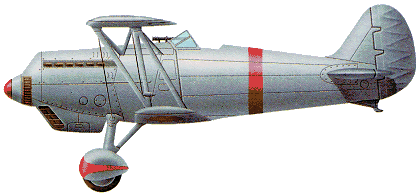 |
Kawasaki Ki-10 Perry / Type 951935 |  |
| FIGHTER | Virtual Aircraft Museum / Japan / Kawasaki |
 |
Four Ki-10 single-seat fighter prototypes made their appear-ance in the spring of 1935, designed by Takeo Doi (who had succeeded Richard Vogt as Kawasaki's chief designer).The Ki-10 was selected in competition with Nakajima's Ki-11 low-wing monoplane, the Japanese Army preferring the Ki-10 biplane's manoeuvrability to its opponent's slightly superior speed. Production Ki-10-1 aircraft were powered by the 633kW Kawasaki Ha-9-IIa liquid-cooled engine, 300 of which were built be-tween 1935 and 1937 and went into service as the Army Type 95 Fighter. They featured biplane wings of unequal span, braced by N-struts and with ailerons on the upper wing only. The divided undercarriage had wheel spats. The all-metal structure was alloy sheet and fabric-covered. Armament comprised two synchronised 7.7mm Type 89 machine-guns. The improved Type 95 Model 2 had increased wing span and length, and vertical tail surfaces of greater area. This version remained in production until December 1938, 280 being completed. Meanwhile during 1936-7 three experimental variants, incorporating modifications to improve performance, were tested but rejected for production. The Ki-10 had excellent dogfighting qualities and proved itself during the second Chinese incident. It took part in the fighting against Russian forces at Nomonhan, although by then (1939) it was largely outclassed. The Ki-10 was coded Perry by the Allies.

|  COMPANY PROFILE | ||||||||||||||||||||||||||||||||||||||||||||||||||||||||||||
 |

|


20
reply